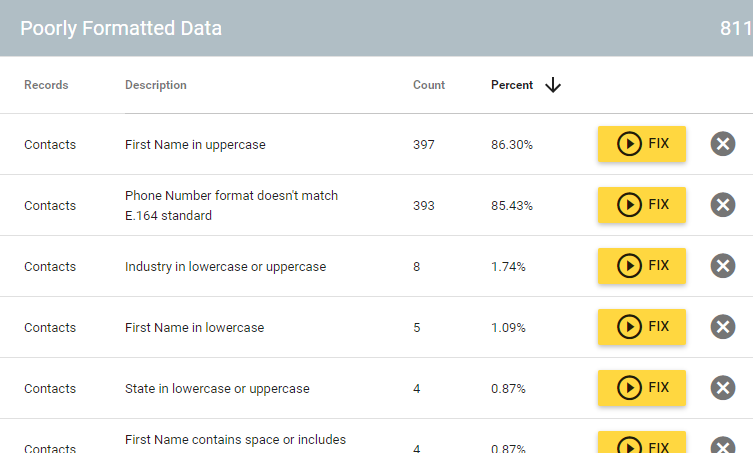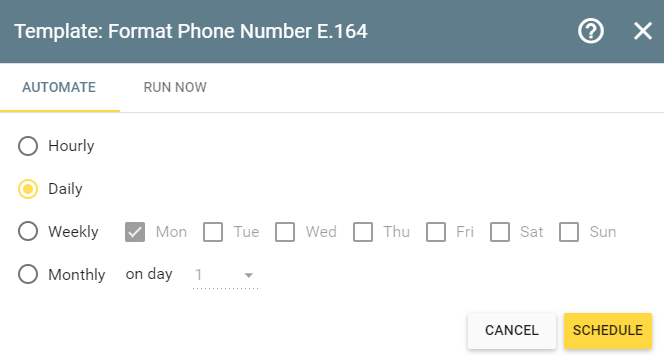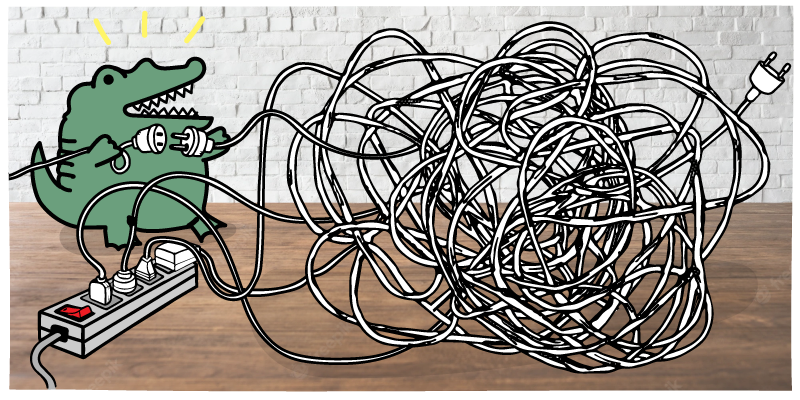When you think of data cleanliness, you probably think about missing data, data with typos and errors, or duplicate records that can clog up the gears of your marketing and sales operations.
But one key aspect of clean data that so many companies overlook is data normalization, which often is even more critical for keeping a customer database clean and organized. In fact, data normalization drives the entire data cleaning process. Without normalized data, it makes it very difficult to fully understand how many data errors are in your customer database.
What is Data Normalization?
Data normalization is structuring your relational customer database to follow a series of standards. This improves the accuracy and integrity of your data, while making your database easier to navigate.
Put simply, data normalization ensures uniformity in how your data looks, reads, and can be utilized—across all of the records in your customer database. This is done by standardizing the formats of specific fields within your customer database.
A customer database might include fields like first names, company names, addresses, phone numbers, and job titles. There are many ways that each of these records could potentially be expressed in a data set.
Here are some examples:
- Names: James vs. james, James A. vs. James, JAMES vs. james. Ensure that all names are properly capitalized.
- Company Names: Acme inc. vs. Acme. Determine whether company registration terms like “inc,” “ltd,” or “LLC” will be included in the field name. You may want to get rid of these appendages for marketing automation reasons.
- Phone Numbers: 1234567890 vs 123-456-7890. Make sure that your phone numbers are easy to read and compatible with systems that use them, such as sales auto-dialing systems. Phone number formatting is critical.
- Job Titles: CEO vs. Chief Executive Officer.
- Addresses: 123 Mulberry St. vs. 123 Mulberry Street New York, New York, 10013
These are standard examples of the type of fields that need to be normalized.
Every company has different criteria when it comes to normalizing its data. Normalized data is critical for the systems that use that data, including marketing automation, sales, and reporting systems.
Six Reasons to Normalize Customer Data
Now the big question—why? Why should I spend all that time and effort to normalize my data? It may seem unnecessary if you’re not noticing any serious problems from non-standardized fields.
Well, the answer to that is simple. Most of the negative effects of low-quality data fly under the radar. Sure, it might be embarrassing when you see that you referred to a prospect as “JAMES” in an automated marketing email. But it’s not the end of the world.
But you don’t see all the hidden effects of low-quality data that never get talked about or make their way up to management. But these effects can hurt companies relying on big data over time.
When you have low-quality data, your marketing teams are scared to inject more data-based personalization into marketing campaigns. Even small mistakes, such as improper capitalization of names, can have an impact on your brand reputation in the long term.
Your sales teams are affected too. Low-quality and missing data means that they lack the critical context they need to speak directly to the biggest concerns of prospects and customers. This directly leads to lower sales and poor quality analysis.
Further, low-quality data negatively impacts lead scoring, which hinders sales reps’ ability to effectively segment and categorize prospects so that they can engage with them effectively.
Here are five of the top reasons all companies should normalize their customer data in some form.
1. Identify Duplicate Data
With normalized data, it is a whole lot easier to find and merge duplicate customer records. Duplicate customer records hinder your customers’ experiences at every point in their journey—including all engagements with marketing, sales, and support, both pre- and post-sale. With duplicate records, companies can never be certain that they are working with complete information when referencing a single record.
When it comes to marketing, duplicate records may result in your prospects receiving the same marketing materials more than once. In sales, splitting a single customer's data between two records means that your sales reps may engage with prospects while lacking the appropriate insights.
2. Improve Marketing Segmentation
How can you effectively segment and categorize customers and prospects so that you can deliver personalized messaging to them, if you don’t have any faith in the data that you are using to do so?
Imagine that you are a B2B company. You want to segment your prospects based on their job titles. It makes sense, right? You don’t want to present your solution to a CEO in the same way that you would a CFO. They have different needs and concerns and your messaging should reflect that.
Without a normalized database, you might find that many prospects that should be segmented into the same bucket are not, because their job titles are so dispersed. For the CEO segment, you might see different segments based on their non-standardized data, like:
- CEO
- Chief Executive Officer
- Owner
- Founder & CEO
- Co-Founder/CEO
Different titles can be used to describe the same segment. Without normalization and standardization, these prospects may end up in different buckets, making analysis difficult.
3. Improve Lead Scoring & Routing
Lead scoring is the process of assigning a value to specific leads or accounts in your CRM so that you can effectively prioritize the best opportunities. Effective lead scoring relies on high-quality data to actively segment those prospects. Using our previous example—a B2B might assign scores to leads using their job title as one of the variables. A CEO might be more valuable than a Marketing Manager as a lead, and the higher score allows your sales teams to prioritize those leads.
Well, without normalized data for the job title, many of your prospects will receive inaccurate scores. This is extended to all fields that are used in the lead scoring process. A lack of normalization across an entire database potentially means that every lead is inaccurately scored.
4. Inject More Data into Marketing Automation
For your marketing team to advance personalization within your marketing campaigns, they need to have faith in the data they are using. If they can’t realistically inject first names into a marketing campaign without a bunch of “JANE,” “jane,” or other common errors in the data being delivered to the customers, they simply aren’t going to use it.
It does more harm than good to send personalized messages using low-quality, non-normalized data.
5. Identify, Aggregate, or Remove Redundant Data
With normalized data, you’ll be able to identify redundant data in a customer data set, even when that redundant data is housed in multiple different fields. In order to normalize data, you have to ask yourself what the field is trying to say. What is it that the data is tracking? With that figured out you can identify when fields are trying to say the same thing and merge them to avoid confusion and limit costs. Aggregating data is critical for analysis.
6. Ensure Integrated Apps Work As Intended
With data normalization, you ensure that you are able to keep third-party apps and integrations working seamlessly. Every app has different specifications regarding how data needs to be formatted to work with the program. Even a simple formatting change can break a third-party integration.
With Insycle's automation features, you can ensure that your data is always formatted as needed and that your integrations with third-party apps never break.
A Tool to Help Normalize Data
Insycle is the perfect tool for normalizing customer data. You can use Insycle’s pre-built templates or customize your own templates for your organization’s data processes. Insycle makes it easy to identify standardization issues and normalize your data.
Additionally, when you first sign up for Insycle, your customer data will be analyzed and a Health Assessment will be generated. Included in this Health Assessment are multiple predefined categories that help companies with normalization and standardization. The Health Assessment provides links to fixing these issues directly.

The Health Assessment allows you to create custom templates, so standardization issues that are specific to your business can be tracked and fixed as they arise.
Further, Insycle makes it easy to ensure that your data is normalized on a regular basis. Once you have your template set up, you can schedule it to run automatically at set intervals.

And, when integrated with HubSpot, Insycle can connect directly to Workflows, ensuring that data is normalized before it even hits your HubSpot database.
Normalize Your Data to Improve Operations
With Insycle, you can normalize data across all relevant fields, and set those templates to run automatically, ensuring that your customer data is clean, consistent, and normalized.
But Insycle is much more than a data normalization tool. It is a complete customer data management platform.
Insycle enables operations teams to fix CRM data quality issues in bulk, and automate the data maintenance process. Without Insycle, the cost of bad data is a major blind spot for marketing and sales leaders and a roadblock for execution by their teams.
Want to learn more about how Insycle can help improve normalization and standardization? Learn more about Insycle's advanced standardization features to improve data consistency in your CRM.






